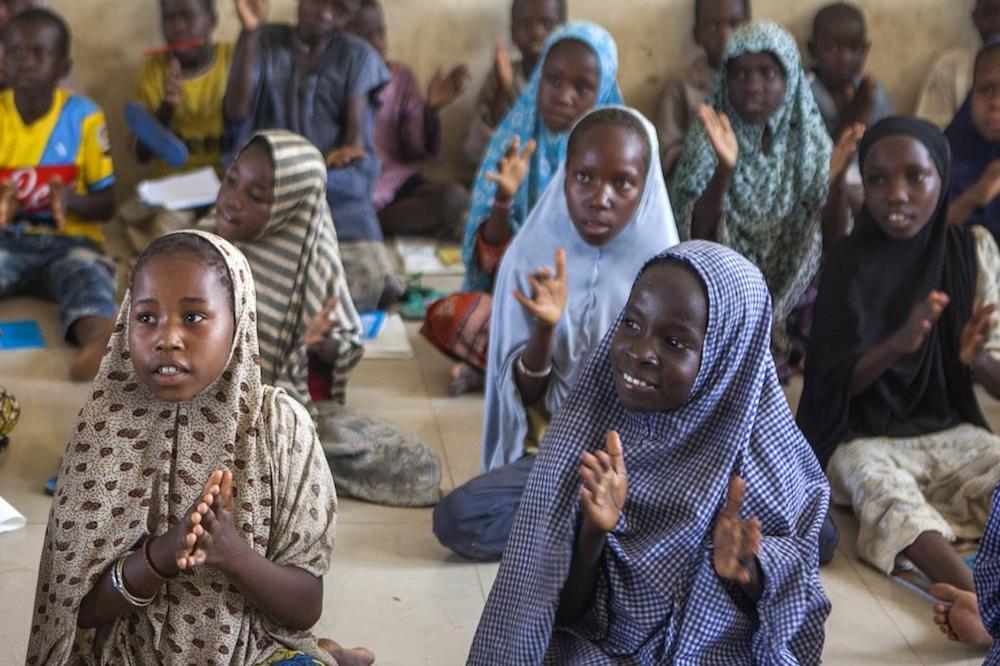
Rural Indian families urged to make school a priority for their children
Child labour
Children at Rajyakaiya School in Narlai village, Rajasthan
On the mud floor of a hut in Rajasthan’s Dungarpur district, seven women and a man sit in a circle around three community workers. One of the community workers, marker in hand, asks why their children or grandchildren don’t go to school regularly.
At first, they are silent. Then one woman pipes up: “The kids keep asking for something or the other – pencils, notebooks and if we don’t get it for them, they don’t go.”
The others murmur their assent. Another woman says: “There is work to be done at home. So they get late for school or don’t finish the schoolwork. But who’ll do the housework then?”
One by one, members of the group – four widows and an uncle among them – call out more reasons, which the community worker writes on a chart taped to the wall. He then gets them to brainstorm solutions.
The challenges of keeping children in the classroom faced by these parents in Rajasthan are seen across rural India.
Children from India’s lower caste communities may be the first in the family to attend school and don’t get much support at home. While education in state schools is free, there are still some expenses such as paying for uniforms or stationery.
A boy walks barefoot to his school near Rohet in Rajasthan
It also means losing a pair of hands to fetch water from the well or to tend to younger siblings.
In the case of older children, it could mean forgoing an additional wage from working alongside the father on a construction site or in the fields.
The challenge is greater in Dungarpur, one of the poorest districts in the state, where the average literacy rate is 58%, according to 2011 data. That compares with a national average of 74% and the state average of 66%.
“Parents don’t regard school as essential – they will pull kids out of school during harvest time or if there is work to be done at home,” said Rukmini Roat, a teacher at a state primary school in Sasarpur village in the same district.
“When the kids get pulled out frequently, they fall behind and then lose interest in studies, then it’s hard for them to advance, so they drop out,” said Roat, who is the sole teacher for the 47 students from grade one to five.
This was the case with Pinki, who dropped out after the second grade to look after her younger brother when her parents took them to neighbouring Gujarat state in search of work.
Hindu students at their state school at Kaparda village
Last year, when the family came back to Dungarpur for a visit, the charity Save the Children intervened. Community workers counselled her mother to leave the children with their grandmother, so they could go to school.
Pinki was re-enrolled in school, in the fourth grade, while her brother started in the first grade.
“I like to study science and learn about the environment,” said Pinki, a slight girl of about 10, who helps her grandmother with chores before she goes to school and when she returns.
“I would like to study more and become a teacher,” she said.
Pinki’s progress is not typical of girls in rural Dungarpur, where the female literacy rate is about 44%, compared with the male literacy rate of 71%, according to 2011 census data.
Enrolment in schools has risen since India enacted the landmark Right to Education Act in 2009, guaranteeing free and compulsory education till the age of 14. Still, the dropout rate was almost 30% at the primary level in 2011.
A girl works at a farm at Sawai Madhopur, near Ranthambore
The rate is likely to be higher in rural Rajasthan, and may climb higher after the state issued an order last month that said only children from families classified as below the poverty line and those from so-called backward castes and tribes, can apply to study in a private school under the education act.
The order would deny more than 300,000 children the right to free private-school education in the state, activists say.
Children who drop out of school are likely to be sent to work. The International Labour Organization estimates there are 5.7 million child workers in India aged five to 17.
More than half work in agriculture and at least a quarter are in manufacturing, embroidering clothes, weaving carpets, making matchsticks or rolling beedi cigarettes.
“The need is so acute that some families have no option but to send older children to work,” said Anita Sharma of Save the Children.
“But they also aren’t aware that there are some government schemes that will give them some money, so they can at least send some kids to school,” she said.
This was the case with Jeeja, who lives with her widowed mother and siblings in Charwara village. After her father died, first her older brother, then Jeeja went to Gujarat to work in construction to help the family.
They’re happy to be heading to school at Doeli in Sawai Madhopur
A social worker, on realising Jeeja had dropped out of school, went to her home and talked to her mother.
She helped her apply for a widow’s pension and other benefits that together bring about 2500 rupees ($38) a month. Jeeja, 14, returned to school and is now in the eighth grade.
“We must let her study,” said her older sister Pramila, who is married. “I wish I had been sent to school. Jeeja mustn’t stop now.”
At the counselling session in Dungarpur, the community workers urge villagers to prioritise their children’s education.
“If they ask for the uniform or a note book, it’s only for school, so don’t get angry with the children,” said Sharma.
“Give them time to do their school work, don’t give them so many chores to do. It’s important that they study.”
The Thomson Reuters Foundation, the charitable arm of Thomson Reuters, covers humanitarian news, women’s rights, corruption and climate change.
More news

